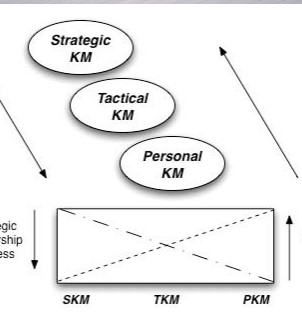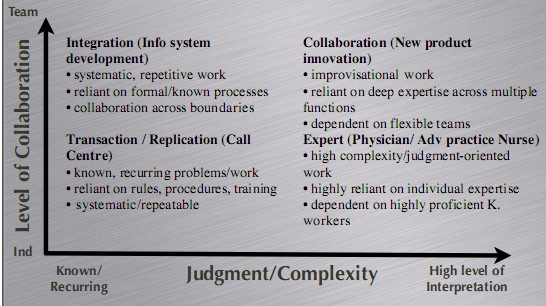信息管理與知識(shí)管理 KM AND IM comparative analysis

信息管理與知識(shí)管理 KM AND IM comparative analysis
To discuss the difference between information management (IM) and knowledge management (KM) first asks us to define them.
1 Information management (IM) is an interdisciplinary field which focuses on information as a resource with an emphasis on collection. The material form in which this information occurs includes book, journals, and databases. Practitioners select, describe, classify, index, and abstract this information to make it more accessible to a target audience, either within or outside their organization. In a development context, IM is concerned to provide transparent and standardized access to information both within and outside the organization. IM has been often framed in terms of tools and technologies to store and organize information.
2 Knowledge management makes sense of information in the context of it's users. Practioners summarize, contextualize, value-judge, rank, synthesize, edit and facilitate to make information and knowledge accessible between people, either within or outside their organization. It concerns itself with the social interactions around the sharing and use of knowledge. KM is largely based on tacit interpretation and less on rules. Some question if knowledge can be "managed" at all. KM has often been framed in terms of knowledge in action for an end purpose. KM implies that the most important drivers relate to human behavior and interchange.
Some see IM as a subset of KM. Ironically, KM is often positioned underneath IM (and more often IT) departments, rather than the other way around.
1、 信息管理“信息管理”這個(gè)術(shù)語(yǔ)自本世紀(jì)70年代在國(guó)外提出以來(lái),使用頻率越來(lái)越高。關(guān)于“信息管理”的概念,國(guó)外也存在多種不同的解釋。.人們公認(rèn)的信息管理概念可以總結(jié)如下:信息管理是實(shí)觀組織目錄、滿(mǎn)足組織的要求,解決組織的環(huán)境問(wèn)題而對(duì)信息資源進(jìn)行開(kāi)發(fā)、規(guī)劃、控制、集成、利用的一種戰(zhàn)略管理。同時(shí)認(rèn)為信息管理的發(fā)展分為三個(gè)時(shí)期:以圖書(shū)館工作為基礎(chǔ)的傳統(tǒng)管理時(shí)期,以信息系統(tǒng)為特征的技術(shù)管理時(shí)期和以信息資源管理為特征的資源管理時(shí)期。
2、 知識(shí)管理由于知識(shí)管理是管理領(lǐng)域的新生事物,所以目前還沒(méi)有一個(gè)被大家廣泛認(rèn)可的定義。Karl E Sverby從認(rèn)識(shí)論的角度對(duì)知識(shí)管理進(jìn)行了定義,認(rèn)為知識(shí)管理是“利用組織的無(wú)形資產(chǎn)創(chuàng)造價(jià)值的藝術(shù)”。日本東京一橋大學(xué)著名知識(shí)學(xué)教授野中郁次郎認(rèn)為知識(shí)分為顯性知識(shí)和隱性知識(shí),顯性知識(shí)是已經(jīng)總結(jié)好的被基本接受的正式知識(shí),以數(shù)字化形式存在或者可直接數(shù)字化,易于傳播;隱性知識(shí)是尚未從員工頭腦中總結(jié)出來(lái)或者未被基本接受的非正式知識(shí),是基于直覺(jué)、主觀認(rèn)識(shí)、和信仰的經(jīng)驗(yàn)性知識(shí)。顯性知識(shí)比較容易共享,但是創(chuàng)新的根本來(lái)源是隱性知識(shí)。野中郁次郎在此基礎(chǔ)上提出了知識(shí)創(chuàng)新的SECI模型:其中社會(huì)化(Socialization),即通過(guò)共享經(jīng)驗(yàn)產(chǎn)生新的意會(huì)性知識(shí)的過(guò)程;外化(Externalization),即把隱性知識(shí)表達(dá)出來(lái)成為顯性知識(shí)的過(guò)程;組合(Combination),即顯性知識(shí)組合形成更復(fù)雜更系統(tǒng)的顯性知識(shí)體系的過(guò)程;內(nèi)化(Internalization),即把顯性知識(shí)轉(zhuǎn)變?yōu)殡[性知識(shí),成為企業(yè)的個(gè)人與團(tuán)體的實(shí)際能力的過(guò)程。#p#分頁(yè)標(biāo)題#e#


信息管理與知識(shí)管理的區(qū)別
(一)在管理內(nèi)容上
信息管理圍繞著信息的收集、加工、檢索和傳播的組織、控制與利用過(guò)程進(jìn)行,管理對(duì)象主要是顯性知識(shí)。而知識(shí)管理不僅僅涉及顯性知識(shí),而更主要的是隱性知識(shí)。這就使其管理對(duì)象擴(kuò)展到了隱性知識(shí)的載體--人上面。
(二)在管理重心上
信息管理強(qiáng)調(diào)管理的技術(shù)和手段,側(cè)重于信息的加工、貯存與傳播,它只是簡(jiǎn)單地對(duì)大容量信息進(jìn)行提取和加工,其信息的加工層次較淺、模式較機(jī)械,一般不具備信息有機(jī)合成和知識(shí)提取的功能。而知識(shí)管理是一種全新的組織管理模式。它以用戶(hù)需求和行動(dòng)決策為核心目標(biāo),重點(diǎn)關(guān)注如何讓信息和知識(shí)的價(jià)值最大化體現(xiàn),使組織內(nèi)人力資源不斷得到信息補(bǔ)給并生產(chǎn)出更多高質(zhì)量的知識(shí)。
(三)在管理目標(biāo)上
信息管理的管理目標(biāo)是以現(xiàn)代信息技術(shù)為手段,對(duì)信息資源實(shí)施計(jì)劃、組織、指揮、控制和協(xié)調(diào)。知識(shí)管理的管理目標(biāo)是在信息管理的基礎(chǔ)上,通過(guò)知識(shí)挖掘和知識(shí)重組實(shí)現(xiàn)知識(shí)共享和知識(shí)創(chuàng)新,從而提高組織的管理和決策能力,發(fā)揮出知識(shí)的資本價(jià)值。
結(jié)束語(yǔ):
綜上所述,信息管理與知識(shí)管理既有聯(lián)系又有區(qū)別,知識(shí)管理是信息科學(xué)發(fā)展中新的增長(zhǎng)點(diǎn),也是信息管理適應(yīng)知識(shí)經(jīng)濟(jì)時(shí)代發(fā)展的必然結(jié)果。
